Blur in scope photography often stems from misalignment between your camera and scope’s optical axis, improper focus settings, or insufficient stabilization. Camera shake, environmental vibrations, and heat mirage can greatly degrade image quality, especially at higher magnifications. Using proper mounting adapters, adjusting diopter settings, and employing a sturdy tripod helps eliminate these issues. Lighting conditions and exposure settings also play essential roles in maintaining clarity. Master these technical elements to transform your blurry images into crystal-clear captures.
What Causes Blur When Photographing Through Your Scope?
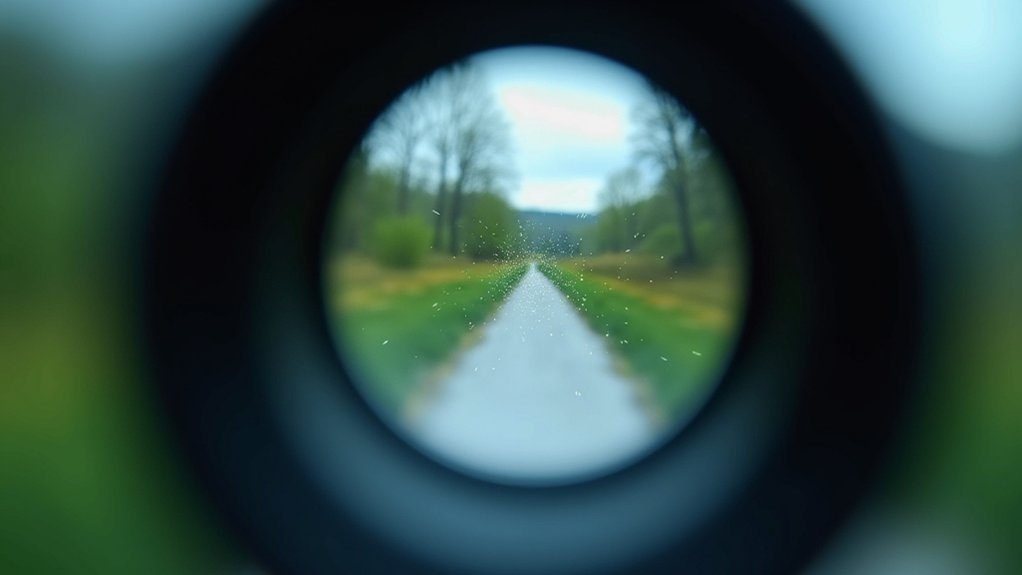
Five common factors contribute to blurry images when photographing through your scope.
First, improper focus settings between your scope and camera lens create unavoidable blurriness—both must be perfectly adjusted for clear focus.
Achieving perfect clarity demands precise coordination between scope and camera focus—anything less guarantees blurry results.
Second, mismatched depth of field occurs when your scope’s focus range doesn’t align with your camera’s, especially when the scope is set for distant targets.
Third, parallax errors develop when your camera isn’t properly aligned with the reticle, causing off-center blurring.
Fourth, environmental conditions like heat mirage and atmospheric distortion can greatly degrade image quality, particularly at higher magnifications.
Finally, camera shake during photography introduces motion blur—even slight movements can ruin otherwise perfect shots.
Understanding these causes helps you systematically address each issue for sharper scope photography.
Optical Alignment Challenges Between Camera and Scope
Achieving perfect alignment between your camera and spotting scope presents one of the most critical challenges in digiscoping photography.
When your camera’s lens axis doesn’t precisely align with the scope’s optical axis, you’ll inevitably end up with a blurry image that fails to capture the detail you’re after.
Even minor misalignments become magnified problems, especially when you’re using your scope at higher magnification settings.
These alignment issues create distortion and focus inconsistencies across your frame. Parallax errors further compound the problem when your camera isn’t positioned correctly relative to the scope’s focal plane.
The different depth of field characteristics between your camera and scope can also work against you.
Using a dedicated camera adapter designed specifically for your scope model greatly improves optical alignment and helps eliminate these frustrating blur issues.
Focus Calibration for Maximum Sharpness
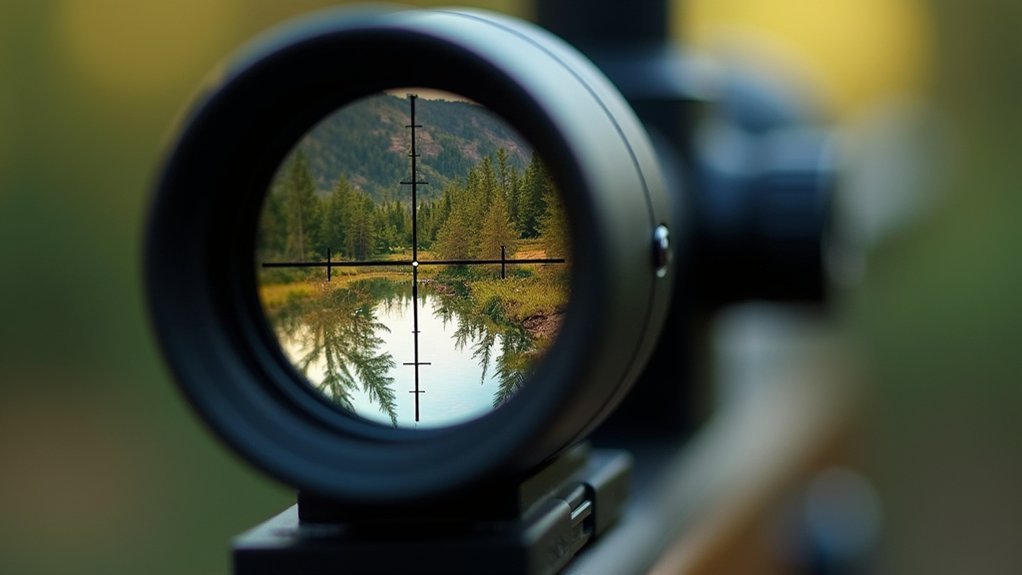
When your photographs through a spotting scope consistently appear blurry despite proper alignment, focus calibration likely needs attention.
The diopter setting on your scope requires precise adjustment to match your eye’s specific characteristics—an incorrect setting guarantees blurry images regardless of other factors.
Don’t overlook parallax adjustment, which becomes vital when photographing targets at varying distances. This setting eliminates the misalignment between the reticle and target plane that causes focus inconsistencies.
Consider using lower magnification for closer subjects, as this increases depth of field and enhances overall sharpness.
Clean lenses are also essential—even minor smudges or dust particles can greatly degrade image clarity.
Finally, test your focus calibration in different lighting conditions, making adjustments as needed to counteract environmental factors that affect sharpness.
Sample Stability and Movement Artifacts
When shooting through a scope, your body’s tiniest movements can greatly amplify blur, especially at higher magnifications.
You’ll notice markedly sharper images by mounting your camera on a solid tripod rather than attempting handheld shots.
Even your breathing pattern and heartbeat can introduce vibrations that compromise image clarity, making proper stabilization techniques essential for crisp photographs.
Movement Vibration Effects
Three major movement factors can ruin your scope photography before you even press the shutter.
First, your own physiology works against you—even slight hand tremors and breathing rhythms introduce subtle movement that translates to blur in your final image.
Second, the scope’s magnification amplifies every tiny vibration; the higher your magnification, the more pronounced this effect becomes.
Finally, environmental conditions like wind or unstable terrain create additional vibrations throughout your entire setup.
You’ll notice these issues most when shooting at high magnification, where even imperceptible movements become glaring problems.
The solution often requires mechanical intervention—a solid tripod eliminates most movement artifacts.
When shooting handheld, consciously control your breathing and utilize proper bracing techniques to minimize these vibration effects that compromise image clarity.
Tripod Support Importance
Although many photographers attempt to capture scope images handheld, a quality tripod represents the single most important investment you’ll make for eliminating blur. The tripod support provides a stable platform that virtually eliminates camera shake—the primary culprit behind fuzzy, unusable images.
When you’re photographing through a scope, even your slightest movements get magnified, creating significant artifacts in your final image. A properly balanced tripod allows you to make precise adjustments without introducing unwanted vibrations.
You’ll also gain the ability to shoot longer exposures in low light without motion blur compromising your results.
Don’t forget that adjustable tripod legs can accommodate uneven terrain, ensuring your setup remains level and steady regardless of where you’re shooting.
Heat Distortion and Mirage Effects

Why does your perfect scope setup sometimes produce frustratingly blurry photos? The culprit might be heat mirage—a phenomenon where rising hot air bends light rays, creating those wavy distortions that ruin your clear sight picture.
Heat mirage turns precision optics into wavering illusions when hot air distorts your perfectly aligned shot.
This effect intensifies during warm weather or after rapid-fire sequences when your barrel heats up. Higher magnification settings actually make mirage more visible, not less. You’ll notice this shimmering effect above hot surfaces or around your barrel.
To combat heat mirage, try timing your shots before significant distortion builds up. Mirage shields can block rising heat waves from interfering with your view.
Additionally, learning to recognize environmental conditions that promote mirage will help you anticipate when to adjust your technique or postpone shooting until conditions improve.
Vibration Sources and Their Impact on Image Quality
Vibration is your enemy when photographing through a scope, coming from your own body movements, unstable mounting hardware, or external environmental sources.
Your rifle’s recoil and breathing pattern can create micro-movements that appear as blur in high-magnification images, while loose scope rings or an unstable tripod will amplify these problems.
Even seemingly minor environmental factors like wind, passing vehicles, or nearby construction can transmit vibrations through your setup and greatly degrade image quality.
Rifle-Induced Movement Effects
When you’re attempting to capture photos through your scope, the various movements generated by your rifle can greatly impact image quality. The vibration from your rifle’s action during firing creates subtle movements that your camera can’t stabilize quickly enough, preventing you from getting a clear shot.
These rifle-induced movements become more problematic at higher magnifications, where even minor vibrations are amplified. Your camera’s shutter speed may also conflict with the frequency of these vibrations, resulting in motion blur.
Environmental factors like wind or uneven shooting surfaces compound these issues.
To minimize these effects, you’ll want to use a tripod or stable shooting platform. Additionally, the quality of your scope matters greatly—better optics maintain clarity under recoil and vibration, helping you capture sharper images through your scope.
Mounting Hardware Stability
Your scope’s mounting hardware serves as the critical connection between your rifle and optics. When screws loosen or mounts are improperly installed, vibrations develop that misalign your scope and create blurry photographs.
Even the recoil from firing your rifle introduces destabilizing vibrations that compromise image clarity.
The quality of your mounting hardware greatly impacts performance. High-quality mounts with shock-absorbing technology effectively minimize vibration transfer, maintaining alignment and producing clear images even under stress.
Materials and design determine whether vibrations are absorbed or transmitted to your scope.
To prevent vibration-related blur, implement regular maintenance checks. Tighten all screws, inspect mounts for wear, and consider upgrading to more stable mounting systems.
These simple steps guarantee your hardware remains stable, delivering the sharp, focused photographs you expect from your scope.
Environmental Vibration Factors
Beyond the scope itself, external forces constantly threaten your photographic clarity. Environmental vibrations from nearby traffic, footsteps, and machinery can shake your scope, resulting in blurred images that fail to capture what you see through the eyepiece.
Wind presents another challenge, creating instability for both you and your camera setup. Even light gusts can disrupt your steady sight picture, especially when you’re positioned on uneven terrain. The closer you’re to a vibration source, the greater its effect on your final image quality.
To combat these external factors, invest in proper stabilization equipment like a sturdy tripod mount or specialized stabilizing devices. These tools greatly reduce vibration transfer to your optics, allowing you to capture crisp, clear images despite challenging environmental conditions.
Lighting Conditions and Exposure Settings
Mastering the interplay between light and camera settings stands as one of the most critical factors in eliminating blur when photographing through a scope.
Poor lighting conditions can dramatically impact image quality, causing underexposure that obscures details or overexposure that washes out your subject.
Your exposure settings must adapt to the available light:
- Shutter speed – In low light, slower speeds capture more light but require stabilization to prevent motion blur.
- Aperture – Controls depth of field and how much light enters; adjust according to your subject distance and desired focus area.
- ISO sensitivity – Higher settings help in dim conditions but introduce grain; lower settings produce cleaner images but require more light.
The right balance between these elements will considerably reduce blur while maintaining image clarity.
Camera Sensor Limitations and Resolution
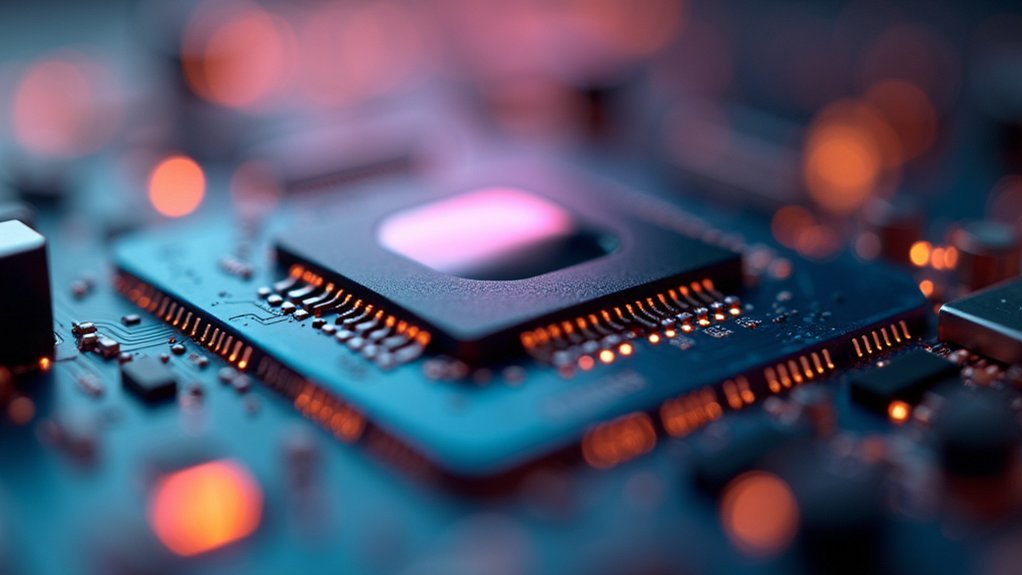
Your camera’s sensor has inherent limitations in how it gathers light compared to your eye, often resulting in underwhelming scope images.
When your camera and scope focal planes don’t perfectly align, details that appear sharp through direct viewing become blurry in photographs.
In low-light conditions, your camera compensates by amplifying the signal, which unfortunately increases digital noise and further degrades the clarity of your scope photos.
Light Gathering Differences
Many camera sensors struggle to match what your eye sees through a scope, particularly in challenging light conditions. When photographing through your scope, you’re fundamentally combining two optical systems with different light gathering capabilities, often resulting in diminished clarity in your images.
- Your eye can adapt to changing light conditions instantly, while your camera sensor has fixed sensitivity that may not capture the same level of detail you observe.
- The effective aperture narrows when shooting through a scope, reducing the light reaching your sensor and potentially causing blur in low-light scenarios.
- Smaller sensors typically found in smartphones and compact cameras collect less light than larger professional sensors, making them more susceptible to blurriness when paired with scopes.
Focal Plane Alignment
When the focal plane of your camera sensor doesn’t perfectly align with your scope’s reticle plane, blurriness inevitably occurs no matter how carefully you focus. This alignment issue is further complicated by camera sensor limitations.
| Factor | Impact on Image Clarity |
|---|---|
| Sensor Resolution | Higher resolution captures more detail for better focus |
| Focal Plane Alignment | Misalignment causes persistent blurriness |
| Depth of Field | Improper scope adjustment leaves portions out of focus |
| Parallax Error | Creates blurring when camera and reticle aren’t aligned |
| Sensor Response Time | Slower sensors struggle with dynamic shooting situations |
Your camera’s sensor quality and resolution directly influence your ability to achieve sharp images. Even with perfect focal plane alignment, a low-resolution sensor will struggle to capture the fine details visible through your scope’s optics. Confirm your camera setup maintains proper alignment for maximum clarity.
Digital Noise Amplification
Three critical sensor limitations directly impact image clarity when photographing through a scope. When your camera’s sensor can’t handle the challenging conditions of digiscoping, digital noise becomes a significant problem.
- Resolution constraints – Lower-quality camera sensors with insufficient pixel density can’t capture the fine details your scope actually resolves, resulting in images that appear grainy and blurred.
- Light processing deficiencies – As you increase ISO to compensate for dim lighting, your sensor amplifies not just the image signal but also unwanted noise, degrading overall sharpness.
- Compound degradation – The combined effect of scope lens imperfections and sensor limitations creates a “double blur” where both optical and digital noise stack up, dramatically reducing the clarity you’d expect.
Eyepiece Selection and Compatibility Issues
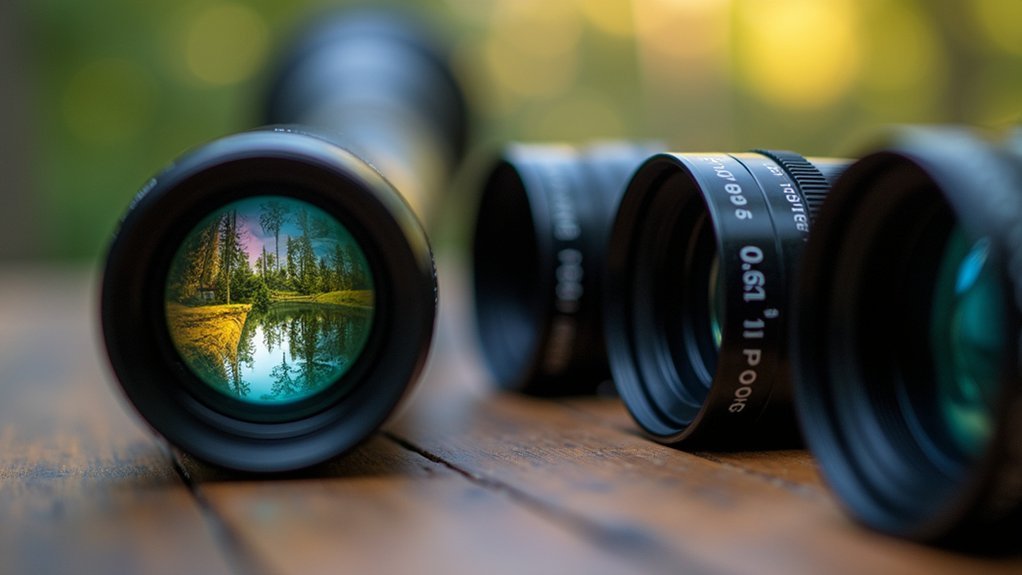
Selecting the right eyepiece for your scope stands as a critical factor in achieving blur-free digiscoping photography. When your eyepiece doesn’t match your camera’s sensor or lens system, you’ll inevitably encounter blurry images and frustrating results.
Compatibility issues often arise when using adapters that aren’t specifically designed for your scope model. This mismatch frequently causes vignetting and focus inconsistencies across your image.
Using mismatched adapters with your scope leads to vignetting and uneven focus that ruins otherwise perfect digiscoping shots.
You’ll need an eyepiece with optical characteristics that enhance photography—look for models with superior light transmission and minimal distortion.
Remember to adjust your eyepiece focus carefully so both the reticle and target appear sharp. The best eyepieces maintain consistent focus at various distances, considerably reducing blur in your photographs.
Don’t underestimate how dramatically the right eyepiece can improve your digiscoping results.
Depth of Field Considerations in Microscopy
Although often overlooked by beginners, depth of field represents a critical factor determining image clarity in microscopy photography.
When you’re capturing images through your scope, remember that depth of field decreases as numerical aperture increases, creating a thinner plane of focus at higher magnifications.
To achieve clear microscopy photographs:
- Adjust your microscope’s diaphragm or aperture to control the depth of field based on your specimen’s thickness.
- Position your specimen precisely within the calculated depth of field to avoid blurriness and distortion.
- Consider the relationship between wavelength of light, lens magnification, and NA when planning your imaging setup.
Understanding these principles helps you anticipate focusing challenges and make informed adjustments before pressing the shutter, ensuring your microscopic subjects appear sharp and properly rendered.
Image Stabilization Techniques for Sharper Results
When photographing through your scope, even the slightest movement can transform a potentially perfect image into a blurry disappointment. To achieve a clear image, always mount your equipment on a tripod or stable surface, ensuring proper alignment between your scope and camera.
Take advantage of image stabilization features in your camera or lenses to counteract vibrations that cause blur. Maintain steady breathing while shooting—don’t hold your breath, but develop a consistent pattern that minimizes body movement.
Faster shutter speeds help freeze motion, especially at higher magnifications where vibrations are more pronounced. For the sharpest results, use a remote shutter release or your camera’s timer function to eliminate the shake that occurs when pressing the shutter button manually.
Digital Processing Artifacts and Enhancement Methods
Three main digital processing artifacts can plague your scope photos: lens distortion, color fringing, and pixelation at high magnification.
These issues often appear along image edges, reducing overall clarity. Fortunately, several enhancement methods can greatly improve your results.
- Apply sharpening filters to increase edge contrast, making your images appear more defined without introducing additional digital artifacts.
- Use software tools to adjust exposure and contrast, compensating for your scope’s optical limitations.
- Capture images at lower magnifications when possible, as excessive zoom typically intensifies blurriness and digital processing artifacts.
Remember that no amount of digital enhancement can fully correct severely blurred images.
That’s why it’s essential to start with the most stable setup possible, typically using a tripod or other stabilizing device.
Frequently Asked Questions
What Is the Most Likely Reason for Blurry Images?
The most likely reason for blurry images is improper diopter adjustment. You’re not aligning the reticle with your eyesight correctly. This prevents both the target and reticle from appearing sharp simultaneously when you look through.
Why Is My Spotting Scope Blurry?
Your spotting scope’s blurriness likely stems from incorrect diopter settings, parallax issues, high magnification problems, environmental factors like heat mirage, or dirty lenses. Regular cleaning and proper adjustment will greatly improve clarity.
What Causes a Rifle Scope to Lose Zero?
Your rifle scope can lose zero due to improper mounting, temperature changes, heavy recoil, frequent adjustments without proper re-zeroing, or maintenance issues like dirt and moisture entering the scope’s internal components.
What Is the Parallax on a Rifle Scope?
Parallax on your rifle scope is the visual misalignment between the reticle and target when viewed from different angles. It’s corrected through adjustment knobs that align both elements perfectly at specific distances for accurate shooting.
In Summary
You’ll improve your scope photography by addressing multiple factors – align your camera properly, calibrate focus precisely, stabilize your samples, minimize heat distortion, use compatible eyepieces, manage depth of field, employ stabilization techniques, and be careful with digital processing. By methodically tackling these issues, you’ll eliminate blur and capture crisp, detailed images that truly represent what you’re seeing through your scope.

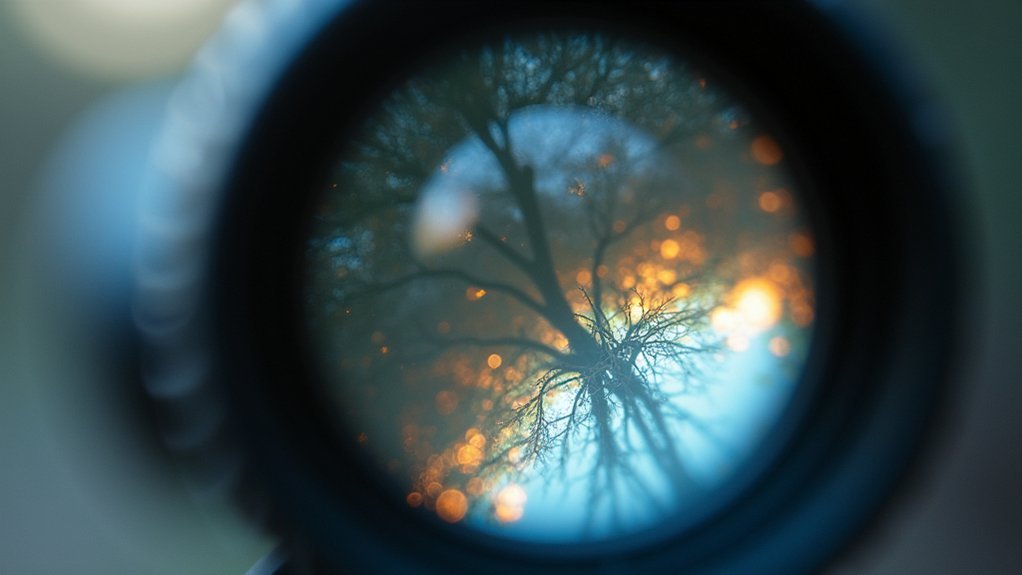



Leave a Reply